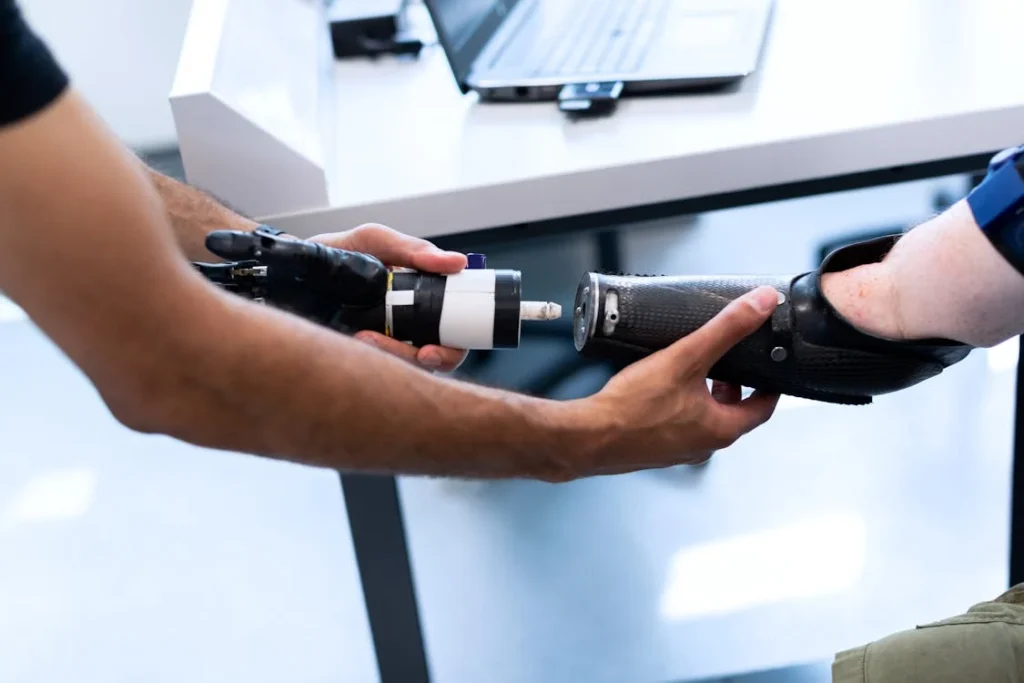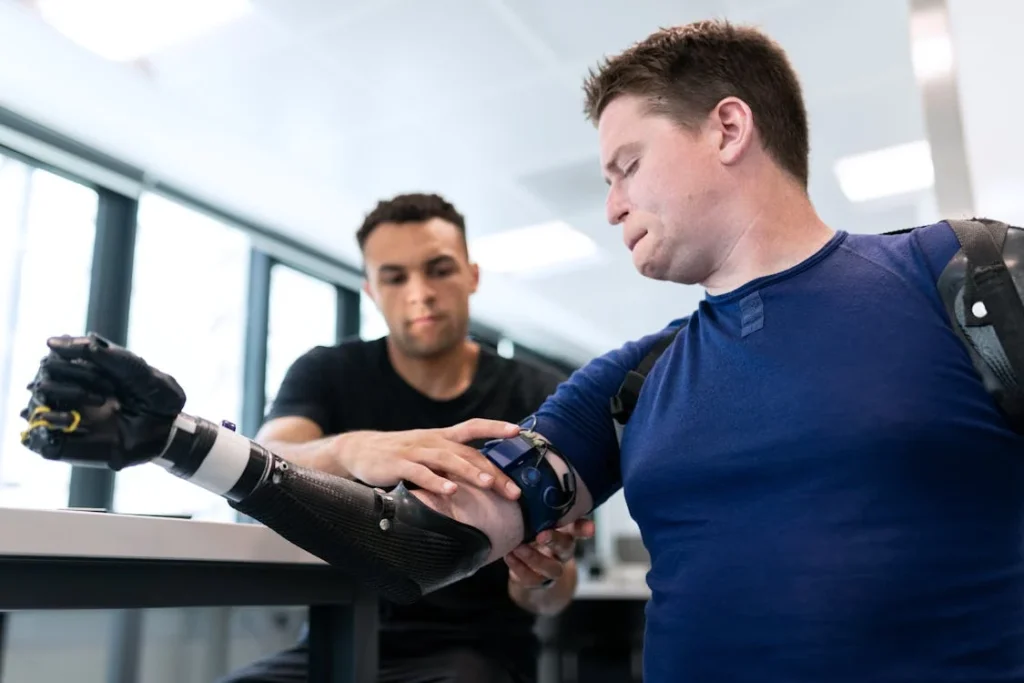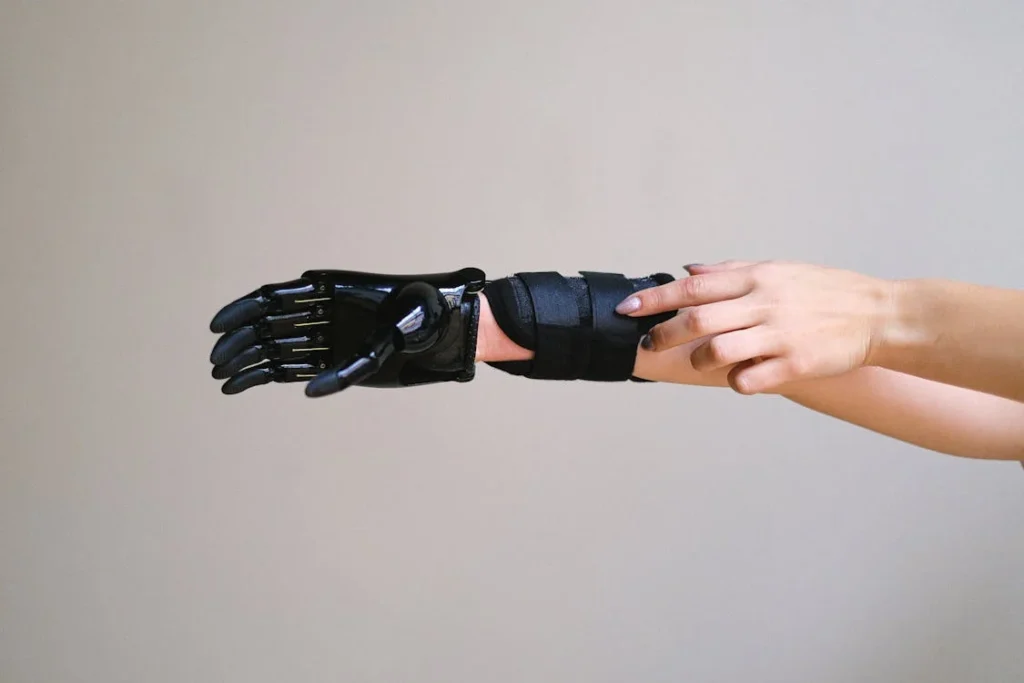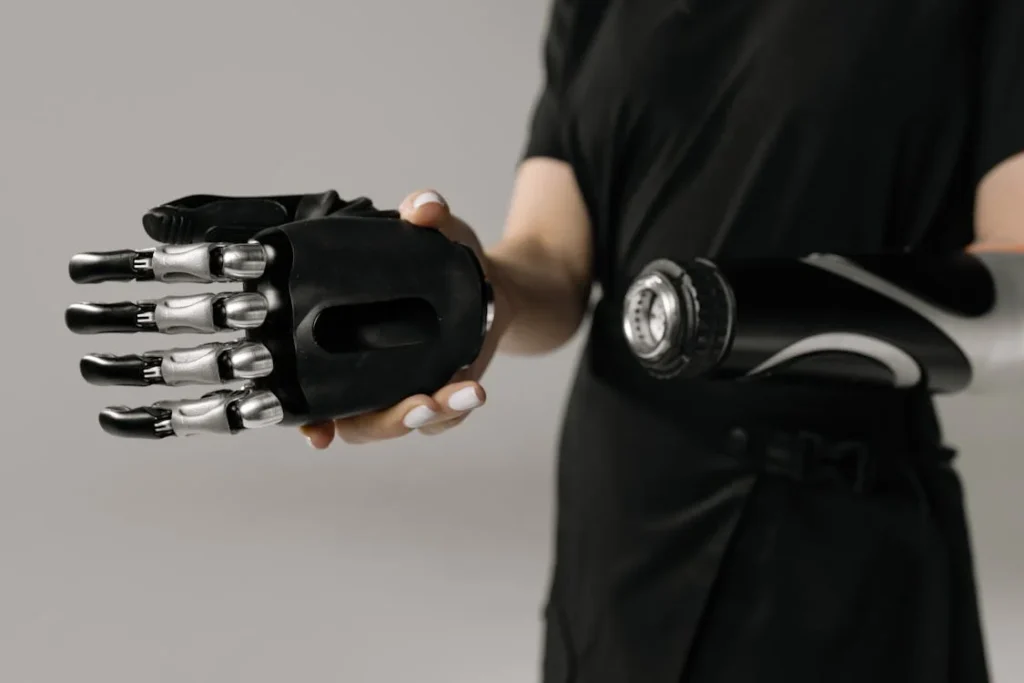A prosthetic socket is more than just a shell—it’s the part of the prosthesis that connects directly to your body. It’s the part you feel every second you wear the limb. It holds, supports, and moves with your residual limb. And for it to work well, everything has to line up—your limb, your healing process, and most importantly, your timing.
At Robobionics, we’ve worked with hundreds of patients across India who’ve taken the journey from surgery to socket. And what we’ve learned is clear: a great socket fit can only happen when your limb is truly ready. If you rush it, you’ll deal with pain, frustration, and setbacks. If you wait too long, your muscles may weaken and recovery may slow down.

Understanding Socket Fit: Why It’s the Foundation of Comfort and Movement
The Socket Is the Heart of the Prosthesis
When people think of prosthetics, they often picture the foot, the knee, or the hand. But what many don’t realise is that the socket is what truly holds everything together. It’s the part that connects your body to your new limb. And if that connection isn’t right, nothing else will be.
You could have the most advanced prosthetic in the world, but if your socket doesn’t fit well, you won’t wear it. Or worse—you’ll wear it and experience pain, skin issues, or poor movement every time you do.
At Robobionics, we always tell our patients that the socket is the most personal part of a prosthesis. It’s custom-made, carefully shaped, and designed to match your residual limb exactly. A small change in angle or pressure can make a big difference in how it feels. That’s why getting it right is essential—not just for comfort, but for long-term success.
The socket doesn’t just hold the prosthetic on your body. It distributes your body weight. It absorbs shock. It helps with balance and stability. It shapes how you walk, stand, or pick things up. In short, it’s the part of the prosthesis that your body speaks to—and that speaks back.
Socket Fit Isn’t One-Size-Fits-All—And It Never Will Be
Every residual limb is different. Some are short, others are longer. Some are round, some are narrow. Some have bone close to the surface. Others are soft or uneven. That’s why sockets can never be made from a standard template. They must be designed with your exact shape, movement, and healing process in mind.
But even with a perfect design, fit is not permanent. Your limb changes. It changes every day, especially in the weeks and months after amputation. It shrinks. It firms up. Sometimes it swells due to heat, pressure, or fatigue. These changes affect how the socket feels and how well it performs.
A socket that fits beautifully one week might feel tight or loose the next. That doesn’t mean the socket is wrong—it just means your limb is still settling. And that’s why timing matters so much. If you fit the socket too early, you may find it doesn’t last. If you wait too long, you may delay recovery and lose the physical momentum you need.
Getting the socket fit right is not about rushing—it’s about watching, listening to your body, and fitting it when your limb is ready. And that takes expert care, patience, and close coordination with your prosthetist.
A Poor Fit Isn’t Just Uncomfortable—It’s Harmful
When a socket doesn’t fit well, the problems go far beyond discomfort. If there’s too much pressure in one area, it can lead to skin breakdown, ulcers, or infection. If it’s too loose, your limb may slide inside, causing friction, heat, and instability.
You may start walking unevenly. You may put more pressure on your healthy leg, leading to hip or back pain. You may develop poor posture, limping, or habits that are hard to reverse. Worst of all, you may lose confidence and stop using the prosthetic altogether.
We’ve seen it happen many times: patients get discouraged not because the prosthetic technology is lacking, but because the socket didn’t fit right—or didn’t stay fitted as their body changed. And once someone starts avoiding their prosthetic, progress slows down. Muscles weaken. Balance suffers. Independence slips away.
This is why we treat socket fit as the most critical part of early rehabilitation. It’s not just about measurements—it’s about timing, communication, and ongoing adjustments.
What Good Socket Fit Feels Like
A well-fitted socket feels secure, but not tight. It holds your limb firmly, without pinching or rubbing. You should be able to move freely without pain. It should feel like an extension of your body—not a device clamped on top of it.
You shouldn’t have to overthink how you stand or walk. You should be able to focus on what you’re doing—not on the socket itself. That’s how you know it’s working.
Getting to this point takes a few fittings, some trial and error, and close feedback with your prosthetist. It also depends heavily on your residual limb being ready—which is something we’ll explore in the next section.
Because here’s the truth: even the most skilled prosthetist can’t create a perfect socket if the limb itself isn’t healed, shaped, and ready for it. That’s why timing really is everything.

Residual Limb Readiness: How Healing, Shrinking, and Shaping Affect Socket Success
The Limb You See Today Is Not the Limb You’ll Have Tomorrow
Right after an amputation, your residual limb is still very much in transition. It’s swollen. It’s tender. It may have stitches, healing wounds, or uneven tissue. At this stage, it’s not ready to take the pressure of a prosthetic socket—especially not one that’s meant to be custom-moulded and worn for hours each day.
What many people don’t realise is how much your limb changes in the first few weeks and months after surgery. This phase, known as limb maturation, is completely normal. Your body is adapting to a major change. The tissue is reorganising. Fluid is draining. Muscles are shifting. And your skin is slowly toughening up to prepare for contact, movement, and pressure.
This is why socket fitting should never be rushed. If you try to fit a permanent socket too early, the shape of your limb will continue to change—and the socket will quickly stop fitting properly. You may feel pain, experience uneven pressure, or notice the limb sliding inside. That can undo weeks of healing in a matter of days.
A smart socket isn’t just one that’s designed well—it’s one that’s designed at the right time.
The Role of Compression and Shaping
One of the most important steps in getting your limb ready for a socket is compression therapy. This is the process of gently applying pressure to your residual limb to help it shrink, shape, and firm up. Compression helps reduce swelling, encourages fluids to move out of the tissues, and guides the limb into a smoother, more stable shape.
If you skip compression—or don’t use it properly—your limb may remain swollen for too long. The soft tissues may stay loose, and your skin might not toughen up as needed. This not only delays your prosthetic fitting, but also increases the risk of poor socket fit and skin breakdown later.
At Robobionics, we educate every patient on proper compression from day one. Whether it’s using a shrinker sock, elastic bandage, or a silicone liner, the goal is the same: to prepare the limb so that when the time for fitting comes, the socket can hug it comfortably and evenly.
We often say: a well-shaped limb creates a well-fitting socket. And that’s not just a nice phrase—it’s a fact backed by decades of experience.
Pain, Sensitivity, and Scar Care All Play a Role
Another part of limb readiness is sensitivity. After surgery, your limb may be extremely tender. Even light touch can feel uncomfortable. That’s natural. But to wear a socket, your limb must be able to tolerate pressure, rubbing, and motion.
So part of the preparation is “desensitisation.” That means slowly introducing touch, massage, and different textures to help your nerves calm down.
It also means taking care of your scar. If your incision hasn’t healed, or if the scar is raised, tight, or inflamed, it can affect the way your socket fits and feels. A scar that sits at the end of your limb will get the most pressure inside a socket. If it’s not managed properly, you might experience sharp pain or even re-injury.
That’s why we recommend starting scar massage early—once the wound is closed. Gently working the area with lotion or oil helps loosen the tissue and makes it more flexible. This is one of those small things that makes a big difference when socket fitting begins.
Understanding Limb Volume Fluctuation
Even after the initial swelling has gone down, your limb’s volume will continue to shift. It might be larger in the morning and smaller by evening. It might swell after long walks or during hot weather. These fluctuations are normal—but they can make socket fit tricky, especially if the limb hasn’t yet stabilised.
This is another reason why timing is so important. If your limb is still changing in size drastically from day to day, it’s usually too early to start designing a final socket. Instead, we may recommend a temporary or test socket—a more flexible option that can accommodate small changes while your limb continues to settle.
By wearing a temporary socket, you give your body time to find a more stable baseline. You also gain real-world feedback—how your limb responds to pressure, movement, or weight-bearing. All of this information helps your prosthetist build a better custom socket later.
The Psychological Side of Readiness
It’s easy to focus only on the physical healing of your residual limb—but emotional readiness plays a role too. After amputation, many people go through a period of grief, fear, or anxiety. They may feel unsure about using a prosthetic or worry that it will hurt.
If a socket is fitted too soon—before someone is emotionally prepared—they might associate it with pain or struggle. That memory can stick, making them less likely to trust the device later, even if the fit improves.
By waiting for both physical and emotional readiness, we help our patients approach the fitting process with confidence. They’re not bracing for pain—they’re excited to move forward. And that makes a huge difference in how they adapt to wearing the socket each day.

The Timing Factor: When Exactly Should You Get Fitted for Your First Socket?
There’s No One-Size-Fits-All Timeline
One of the most common questions we get at Robobionics is, “When can I get my first socket?” And while it would be great to have a fixed answer, the truth is—it depends. Every body heals differently. Every surgery is different. And every person’s recovery journey moves at its own pace.
That said, we’ve found general patterns that can help guide this decision. Most patients are ready to start using a temporary or early-stage prosthetic socket within 4 to 8 weeks after surgery. But that’s only if certain conditions are met: the incision must be fully closed, swelling should be well controlled, pain should be manageable, and the limb should be responding well to compression and basic mobility.
Rushing into socket fitting before these milestones can lead to frustration and setbacks. Waiting too long, on the other hand, can result in loss of muscle strength, poor posture habits, and delayed emotional recovery. Timing is a careful balance—not too soon, not too late.
Signs That You’re Likely Ready for Your First Fitting
There are clear indicators that your residual limb is on the right track. If your scar is well-healed and flexible, and your skin can tolerate gentle touch or rubbing without pain, you’re on a good path. If you’ve been consistently using a shrinker sock or compression sleeve, and your limb has become smaller and firmer over time, that’s another strong sign.
You should also be able to bear light weight through your limb—even if it’s just in a sitting or standing position. If the idea of wearing a liner or having pressure on your limb doesn’t make you anxious, it means your body (and mind) are beginning to accept the prosthetic process.
At this point, your prosthetist might suggest starting with a diagnostic or test socket. This isn’t your final socket—it’s a temporary version used to understand how your limb behaves under pressure, how you walk, and where you might need more or less support.
This early phase of socket use is more about observation and feedback than performance. You and your prosthetist work together closely to make adjustments, fine-tune the shape, and get your limb used to the feeling of being enclosed.
Why Delaying Too Long Can Create New Problems
It’s natural to be cautious after surgery. Many people worry that walking on a healing limb will hurt or slow their recovery. But what we often see is that too much delay creates a different kind of harm.
Muscles begin to weaken if they’re not used. Joints become stiff. Your body starts to favour the healthy leg, which throws off your alignment and creates back or hip pain. Most importantly, the longer you go without walking or moving naturally, the harder it becomes to relearn those skills later.
The window for easy recovery starts to shrink. What would’ve been a smooth transition with a well-timed socket becomes a frustrating challenge. This is why timing matters. You don’t want to wait until your body has adapted to life without the prosthetic. You want to introduce it while your brain and muscles are still open to relearning.
Early use of a well-fitted socket helps keep your systems—physical and neurological—engaged. It builds the habit of using the limb, strengthens the connection between your brain and your new body movements, and keeps you emotionally involved in your recovery.
Work With Your Team, Not Against the Clock
One of the best things you can do is communicate often with your healthcare team. Your surgeon, physiotherapist, and prosthetist should work together to monitor your progress. At Robobionics, we create shared recovery plans that allow everyone to track how your limb is healing, how your strength is developing, and how prepared you are for prosthetic use.
We never push someone into a socket before their body is ready—but we also don’t let hesitation slow down progress that could be safe and beneficial.
The key is consistent evaluation. That might mean weekly check-ins, photos of your limb, measurements, or gait observations. By combining visual signs with patient feedback and functional testing, we’re able to recommend the right moment to start—and help you make the most of it.
When all these pieces come together—medical readiness, emotional readiness, and timing—you experience a smoother, more successful start to prosthetic life.

Socket Adjustments and Follow-Up: Why Your First Fit Is Only the Beginning
No Socket Stays Perfect Forever
The moment you receive your first socket, you’ll likely feel a mix of excitement and uncertainty. Excitement because it’s a major step forward. Uncertainty because—even with all the right timing and preparation—it won’t be perfect forever. That’s not a flaw. That’s reality. Your body continues to change, especially in the first year after amputation, and your socket needs to change with it.
At Robobionics, we always explain to patients that your socket isn’t a one-time fix. It’s part of an ongoing relationship between your body, your prosthetic, and your care team. As your limb settles, your needs will evolve—and your socket must evolve too.
That’s why follow-up care is just as important as the fitting itself. Small discomforts today can become big problems tomorrow if left unaddressed. Regular check-ins, even if you’re feeling fine, help us spot changes early and make small corrections that keep you comfortable, mobile, and confident.
Your Limb Keeps Changing—And That’s Normal
One of the most overlooked truths about amputation recovery is that limb volume continues to fluctuate for months. Your body might lose fluid, gain muscle, or shift tissue in response to walking, standing, weather, hydration, or simply time. Even your activity level plays a role—more walking can lead to more shrinkage, while long periods of sitting or illness can cause swelling.
These changes, even if they’re small, affect how your socket feels. You might notice more pressure at the end of your limb. Or a gap near the top. Or rubbing on one side when you walk. These are not signs that something is wrong—they’re signs that your limb is progressing. But your socket needs to keep up.
Some people try to fix these issues themselves by adding extra socks, shifting the liner, or reducing how much they wear the prosthesis. But these workarounds don’t fix the problem. They just delay proper care. If you notice a change in fit, talk to your prosthetist. Sometimes all it takes is a simple pad adjustment or a liner swap to make things right again.
Adjustments Are a Sign of Progress, Not Failure
Many patients feel discouraged when their socket needs adjustment, especially if it happens more than once. They wonder if something went wrong. But the truth is: needing changes is expected, and it usually means your limb is healing and adapting as it should.
In fact, the first few sockets you use—often called test sockets or preparatory sockets—are built to be adjusted. We expect to modify them. We expect feedback. This is part of the process, not a setback.
At Robobionics, we encourage every patient to speak up about what they feel. Don’t tough it out. Don’t wait until it’s unbearable. Tell us if something feels off, even slightly. That’s how we fine-tune the fit so that you stay active, healthy, and motivated.
We also build feedback sessions into our care model. You won’t just get fitted and sent home. We’ll follow up within days and weeks, checking not just your physical fit but also how your daily activities feel. Are you moving freely? Are you standing for longer periods? Is your confidence growing? These are the markers of real success—not just how the socket looks on paper.
Signs That It’s Time for a Refitting or a New Socket
There comes a point when adjustments aren’t enough—and that’s when a new socket might be needed. This doesn’t mean the first one failed. It simply means your body has moved forward, and your prosthesis needs to match it.
You may notice new pressure spots that don’t go away. You may feel like your limb is sinking deeper into the socket, or sliding around inside. The prosthesis might feel less stable than it once did, or you may start using it less because of mild discomfort that gradually becomes more noticeable.
Sometimes, these changes can be fixed with small adjustments. But when they keep recurring, or when your limb size has changed significantly, it’s time to talk about a new socket.
We typically reassess socket needs every 6–12 months in the first year, depending on your healing and usage. A new socket, built on updated scans and real-time data, ensures that your prosthesis keeps up with your progress—not the other way around.
Socket Fit Isn’t a Destination—It’s a Dialogue
One of the most empowering things you can learn as a prosthetic user is this: your comfort is not a fixed point. It’s a conversation. Between your body and your device. Between your goals and your care. Between your experience and your prosthetist’s skill.
You don’t have to “live with” poor fit. You don’t have to guess what’s normal or ignore warning signs. You have the right to ask for help, to expect adjustments, and to stay involved in your own journey.
At Robobionics, we build relationships—not just devices. We want you to walk out of our clinic not just with a prosthesis, but with the tools, support, and confidence to use it well. And that begins with the understanding that socket fit isn’t a one-time achievement—it’s a lifelong dialogue rooted in timing, trust, and teamwork.

The Impact of Limb Volume Management on Socket Fit Success
What You Do Between Appointments Matters More Than You Think
Once your socket has been fitted and you’ve begun using your prosthesis, it’s easy to think the hard part is over. But in reality, your day-to-day choices—what you wear, how you move, and how you manage your limb—have a huge effect on how well your socket continues to fit.
That’s where limb volume management comes in. This refers to how you maintain the shape, size, and firmness of your residual limb between prosthetic check-ins. It’s not a single step. It’s an ongoing habit. And when done right, it helps you avoid discomfort, prevent injury, and extend the life of your socket.
At Robobionics, we’ve seen countless patients come back after a successful fitting only to say, “It doesn’t feel quite the same anymore.” And more often than not, the issue isn’t the socket itself—it’s that the limb has changed because it wasn’t managed well during daily life.
Volume Loss and Gain Happens Constantly
Your residual limb is made up of muscle, fat, fluid, and skin—all of which respond to your activity level, hydration, temperature, and even diet. After amputation, your body naturally adjusts to the new anatomy. You may lose soft tissue or muscle mass in the limb over time. You may also gain swelling from standing too long, eating salty food, or simply being less active for a day or two.
What many patients don’t expect is just how quickly these changes can affect socket fit. A little swelling can create too much pressure. A little shrinkage can make your limb feel loose or unsupported. And when your socket doesn’t fit snugly, you begin shifting inside it, which leads to skin rubbing, instability, and discomfort.
That’s why managing your limb volume daily is essential—even more so during the first six months post-fitting.
The Role of Prosthetic Socks and Liners in Daily Fit
One of the simplest tools in volume management is the prosthetic sock. These are soft, breathable layers that you wear over your limb before putting on the socket. They come in various thicknesses—commonly referred to as “ply”—and help fill in the space when your limb has shrunk slightly or when your socket feels too roomy.
What’s important to remember is that prosthetic socks aren’t just padding. They’re precision tools. Using too many layers, or the wrong ply, can throw off your alignment. Not using any when your limb has shrunk can lead to friction and injury. That’s why you should monitor how your socket feels each morning—and adjust accordingly.
You should also inspect your liner, especially if it’s made of silicone or gel. A worn-out or stretched liner may no longer offer consistent pressure or grip, which can mimic the feeling of volume loss. Replacing your liner regularly—or rotating between two—can keep your socket fit more stable throughout the day.
At Robobionics, we educate patients on how to use a sock diary. Each morning, you note how many layers you needed and how the socket felt by the end of the day. Patterns quickly emerge, giving you a better sense of how your limb is reacting to activity, weather, or changes in routine.
Managing Volume with Activity and Rest
Your activity level also plays a key role in managing your limb volume. Movement promotes blood flow and fluid balance, which keeps swelling down. But overactivity—especially long hours of standing or walking—can create inflammation or pressure buildup in the limb.
The opposite is also true. Being sedentary for long periods causes fluid to pool. If you spend hours sitting without your prosthesis on, you may find your limb swollen and puffy when you try to wear it again.
To avoid these extremes, balance is key. Throughout the day, take short breaks. Elevate your limb when resting. Use gentle massage or tapping to encourage circulation. Don’t sit for too long without changing positions. And if you notice your limb always feels tighter in the evening, consider using a light compression wrap when you’re not wearing your prosthesis.
These habits sound small, but they add up to big improvements in how your socket fits and how confident you feel using your limb each day.
Preparing for Long Days and Special Conditions
Travel, illness, heat, and changes in schedule can all affect your residual limb. On hot days, for example, your limb may swell faster. During illness or fatigue, you may retain more fluid. Even flying on an airplane can cause swelling due to pressure changes.
The key is being proactive, not reactive. If you’re planning a long day on your feet, start with a slightly thicker sock and carry extras in your bag. If you’re recovering from a cold or surgery, wear your prosthesis in shorter intervals until your limb returns to its usual state. Keep your skin clean and dry to prevent rashes or breakdowns, especially when sweating more.
We always encourage our patients to develop what we call a “limb awareness habit.” Pay attention. Take five minutes each day to inspect your limb. Notice changes in shape, color, or feel. That daily check-in can prevent most socket-related issues before they start.

Weather, Climate, and Geography: How Environment Shapes Socket Comfort and Limb Readiness
Where You Live Can Change How Your Prosthesis Feels
It’s not something most people think about when they imagine using a prosthetic limb—but the weather, your local climate, and even altitude can all have a noticeable impact on how your residual limb feels and how well your socket fits. In India, where we serve patients from the humid coasts of Kerala to the dry heat of Rajasthan to the cooler elevations in Himachal Pradesh, these differences really matter.
Your limb doesn’t exist in a vacuum. It responds to your environment—constantly. And if you’re not prepared for those shifts, you might assume something is wrong with your socket when, in reality, it’s your surroundings affecting the fit.
Understanding how your geography and daily weather influence your body is a smart way to prevent discomfort and make the most of your socket, no matter where you are.
Humidity and Heat: The Common Comfort Killers
In high-humidity areas like Mumbai or Chennai, patients often notice that their limb feels sweaty inside the socket within minutes of use. Moisture buildup is uncomfortable, but worse, it can lead to skin breakdown, bacterial growth, and even infection. When sweat pools inside the liner, the skin softens and becomes more prone to rubbing, especially around bony areas or scar tissue.
Humidity also makes it harder for your skin to breathe, and liners that once felt fine might begin to slip. This can lead to increased friction, which leads to irritation—and that eventually leads to a reluctance to wear the prosthetic at all.
To combat this, we often recommend moisture-wicking liners, breathable prosthetic socks, and shorter wear intervals in hot, sticky weather. We also suggest washing the liner more frequently during the summer and applying a talc-free drying powder (or antiperspirant designed for prosthetic users) before putting on the prosthesis.
If you live in a coastal region or spend a lot of time outdoors in heat, you should be even more vigilant about skin checks. Redness, itching, or a rash are all signs that sweat is interfering with your skin health—and ultimately your socket comfort.
Cold and Dry Air: Subtle but Powerful Shifts
At the other end of the spectrum, people living in cooler or drier climates—like Shimla, Dehradun, or parts of Ladakh—often experience the opposite problem. The skin on the residual limb can become dry, flaky, or even cracked. This makes putting on a liner or socket painful and can reduce the limb’s tolerance for pressure.
Cold weather also causes blood vessels to tighten, which may lead to temporary limb shrinkage. What felt like a snug fit in October may suddenly feel too loose in January. Patients may notice air gaps inside the socket, especially after sitting for long periods. These gaps increase movement inside the socket and reduce stability, particularly during activities like climbing stairs or navigating uneven ground.
To prevent this, we encourage daily moisturising with non-greasy, skin-safe lotions. We also recommend adjusting sock ply more frequently during seasonal transitions and wearing thermal liners that trap heat without causing sweat buildup.
Just like in hot weather, the key in colder areas is proactive care. If your socket suddenly feels different, consider what’s changed in your environment before jumping to conclusions about the socket itself.
Altitude and Air Pressure: The Silent Socket Shapers
You might not think altitude has anything to do with socket fit—but if you travel from a city at sea level to a higher-altitude location, you might feel unexpected tightness or swelling in your residual limb. This is due to changes in atmospheric pressure and reduced oxygen levels, both of which can cause your body to retain fluid as it adjusts.
We’ve had patients fly from Delhi to Leh or drive from Pune to Mahabaleshwar and report discomfort after just one day. The limb may feel heavier, or the socket might feel tighter around the end. It usually settles within a few days, but knowing to expect it helps you prepare.
If you’re planning to travel to higher elevations, let your prosthetist know. You might need to bring extra socks or a softer liner for those days. You should also avoid overexertion in the first 48 hours at altitude, as physical stress can increase swelling further.
Traveling Across Regions? Your Socket Strategy Should Travel With You
One of the great things about living in a country as diverse as India is that travel between climates is common—especially for work, family visits, or festivals. But this can create challenges for prosthetic users if they’re not prepared.
If you’re heading from a humid zone to a dry area (or vice versa), take time to check your limb at the end of each day. Pack extra liners, powders, socks, or moisturisers depending on where you’re going. And don’t be afraid to reach out to your prosthetist remotely if the fit starts feeling “off.”
At Robobionics, we help patients create socket travel kits—simple pouches with everything they might need for volume management and skin care on the go. We’ve seen how this preparation helps people enjoy their journeys more fully and avoid last-minute problems that could derail a trip.
Where the Body Meets the World, the World Matters
In the end, your prosthetic socket doesn’t just connect you to your limb—it connects you to the world. That world includes temperature, humidity, elevation, and environment. When we ignore those factors, we miss part of the picture. When we embrace them, we create a more holistic, comfortable, and resilient experience.
Your geography doesn’t have to be a challenge. It can be part of your care strategy. And when it is, your prosthetic becomes not just a tool—but a partner you can rely on, wherever life takes you.
Conclusion
Socket fit isn’t just a step in the prosthetic process—it’s the foundation of everything that follows. And getting it right depends on much more than the shape of your limb. It’s about timing, healing, volume management, daily habits, and even your local environment. When you understand how all these pieces connect, you’re no longer guessing—you’re taking control.
At Robobionics, we believe a well-fitted socket isn’t just about comfort. It’s about confidence, movement, and living without limits. Whether you’re just starting your journey or adjusting to changes months later, remember this: your limb is always evolving, and your socket should evolve with it.
With the right support, the right care, and the right timing, your prosthesis can become a seamless part of your life—not just a device, but an extension of your strength and independence.
Because when socket fit and limb readiness align, everything else falls into place.



